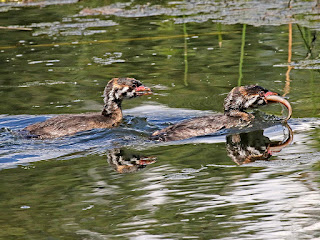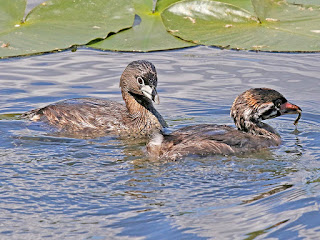The Pacific Northwest has just one venomous snake, the
Pacific Rattlesnake Crotalus oreganus.
Formerly considered conspecific with the Prairie Rattlesnake Crotalus viridis, ours has been split
from that species. The Prairie does occur just to the east in parts of Idaho
and Montana.
Rattlesnakes aren't found in the wetter regions west of the
Cascades summits but are common on the east side, usually in drier habitats
below 3000 feet in elevation. They prefer rocky areas, probably because they
can retreat into winter dens where there are a lot of crevices, but they also
occur away from rocks. They are diurnal in spring when night temperatures are
low but nocturnal in summer when daytime temperatures become too high for these
ectothermic reptiles.
Our rattlesnakes grow to about three feet in length, but
most I have seen are around two feet. I would be shocked to see one much bigger
than that in Washington/Oregon. They eat primarily warm-blooded prey,
especially small mammals, but they'll take a bird if they can get it, not to
mention other reptiles and amphibians. The young ones especially are likely to
have a broader diet of smaller animals, even insects. Rattlesnakes are pit
vipers, with a pair of heat-sensitive pits just behind the nostrils that can
detect a mammal's body heat in the dark. They strike their prey with a pair of
fangs that fold out when used, injecting them with a potent venom. The venom is
full of proteolytic enzymes and quickly causes tissue destruction and death in
a small animal. The prey may have run away, the snake follows the scent trail
to find the dead animal.
The venom is also a very effective defense, and any large animal would suffer even from a nonlethal bite. Over evolutionary time, natural selection favored snakes that failed to shed the very tip of their tail but instead added another segment that made noise when vibrated against its neighbors, much enhancing the tail vibration that some other snakes also practice in defense. Snakes shed their skin 2-3 times a year, so a rattle would be a fairly good indicator of the age of the snake except that terminal segments often break off.
Fortunately for Northwesterners, Pacific Rattlesnakes are
not especially aggressive, and their venom is less toxic than that of their
relatives to the south. Nevertheless, don't try it! Watch where you walk when
in rattlesnake country, especially among rocks, and don't put your hand
somewhere that you don't scrutinize first for the presence of one of these
cryptic snakes.
Dennis Paulson














